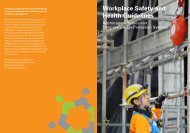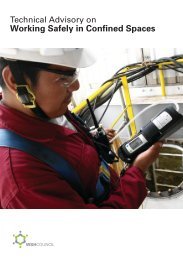Guide to WSH Obligations for Shipmasters and Contractors for ...
Guide to WSH Obligations for Shipmasters and Contractors for ...
Guide to WSH Obligations for Shipmasters and Contractors for ...
Create successful ePaper yourself
Turn your PDF publications into a flip-book with our unique Google optimized e-Paper software.
<strong>Guide</strong> <strong>to</strong> <strong>WSH</strong> <strong>Obligations</strong><strong>for</strong> <strong>Shipmasters</strong> <strong>and</strong> Contrac<strong>to</strong>rs<strong>for</strong> Anchorage Works
ContentsSection 1Master's <strong>Obligations</strong> under the Workplace Safety <strong>and</strong> Health Act1. Foreword 22. Introduction 23. Contrac<strong>to</strong>rs 24. General Works 25. Safety Group (VSCC Equivalent) 45.1 Composition5.2 Function6. Confined Spaces 56.1 Control of entry in<strong>to</strong> confined space6.2 Other confined space issues7. Work at Height 68. Lifting/ Hoisting 79. Scaffolds 710. Drowning Hazard 711. Emergency Response 712. Incident Reporting 813. More Useful Links 8Section 2Contrac<strong>to</strong>r's <strong>Obligations</strong> under the Workplace Safety <strong>and</strong> Health Act14. Foreword 915. General Works 916. Risk Management 917. Confined Spaces 1018. Incident Reporting 1019. More Useful Links 111
Master's <strong>Obligations</strong> under the Workplace Safety <strong>and</strong> Health Act1. ForewordDear Shipmaster,The Workplace Safety <strong>and</strong> Health (<strong>WSH</strong>) Act is a critical component of the <strong>WSH</strong> framework that wasdeveloped <strong>to</strong> raise <strong>and</strong> improve the occupational safety <strong>and</strong> health st<strong>and</strong>ards in Singapore.It requires all stakeholders (including owner/master/agent) <strong>to</strong> do their part by taking reasonably practicablesteps <strong>to</strong> ensure the safety <strong>and</strong> health of every person at work.As you will be hiring the services of local contrac<strong>to</strong>rs <strong>to</strong> work on board your vessel in Singapore, this guidewill provide guidance on carrying out these works safely.A list of links <strong>to</strong> relevant Legislation <strong>and</strong> Codes of Practice is also provided at the end of this guide <strong>for</strong> yourreference.Thank you.2. IntroductionGood <strong>WSH</strong> requires the co-operation <strong>and</strong> concerted ef<strong>for</strong>ts of all stakeholders. The aim of this guide is <strong>to</strong>provide in<strong>for</strong>mation <strong>and</strong> guidance <strong>to</strong> meet the requirements of the <strong>WSH</strong> Act <strong>and</strong> its subsidiary legislations.To ensure the safety <strong>and</strong> health of persons working on board ships, all stakeholders must carry out theirroles <strong>and</strong> responsibilities, <strong>and</strong> carry out work safely.3. Contrac<strong>to</strong>rsWhen contrac<strong>to</strong>rs board your ship <strong>to</strong> per<strong>for</strong>m work, you <strong>and</strong> the contrac<strong>to</strong>rs should discuss the following:• Potential hazards on the vessel that may affect them <strong>and</strong> potential hazards that may be createddue <strong>to</strong> their work;• Control measures <strong>to</strong> mitigate risks;• Safety data sheets of chemicals found on your vessel <strong>and</strong>/or used by the contrac<strong>to</strong>r;• Safety rules <strong>and</strong> st<strong>and</strong>ard operating procedures that will affect either party; <strong>and</strong>• Shipboard emergency procedures should be clearly briefed <strong>to</strong> the contrac<strong>to</strong>r prior <strong>to</strong> startwork, means of escape <strong>and</strong> emergency exits are <strong>to</strong> be highlighted.4. General Works• Ensure that the Commissioner <strong>for</strong> <strong>WSH</strong> has been notified by the masters/agent/owner <strong>for</strong>the circumstances listed below under the <strong>WSH</strong> (Shipbuilding <strong>and</strong> Ship-repairing)Regulations• Appoint Ship Repair Manager• Ensure contrac<strong>to</strong>rs have controlled the work risks <strong>to</strong> as low as practicable• Implement control measures <strong>to</strong> prevent persons from falling in<strong>to</strong> water or rescuing suchpersons2
For general types of works, the Ships’ Owner/Master must do the following.i. Ensure that the Masters/Agent/Owner has notified the Commissioner <strong>for</strong> <strong>WSH</strong> three days inadvance, be<strong>for</strong>e any work listed under the <strong>WSH</strong> (Shipbuilding <strong>and</strong> Ship-repairing) Regulations isdone such as:• Construction, re-construction, repair, refitting, painting, finishing or furnishing of a ship;• Scaling, scurfing or cleaning of boilers (including combustion chambers <strong>and</strong> smoke boxes) inthe ship;• Cleaning of any tanks, bilges or holds in a ship; <strong>and</strong>• Survey or inspection of a ship or its contents not carried out by the ships’ crew.ii.Appoint an appropriate Ship Repair Manager that has received adequate training in <strong>WSH</strong> so that hecan:• Take the lead <strong>and</strong> co-ordinate all activities relating <strong>to</strong> the repair on board the ship;• Ensure that no work is done on the ship without approval;• Issue, moni<strong>to</strong>r <strong>and</strong> revoke permits <strong>to</strong> work (PTW) <strong>for</strong> hazardous work. PTW is a <strong>for</strong>m ofadministrative control <strong>to</strong> identify potential risks involved be<strong>for</strong>e the work is being carried out;• Ensure that the master/owner/agent appoints a safety assessor <strong>for</strong> hazardous work;• Ensure that no hazardous work is <strong>to</strong> be carried out without a PTW;Types of high-risk work that require a PTW(a) Work that involves the use of any hazardous, volatile, corrosive orflammable chemical, material or solvent in significant quantities(b) Work involving entry in<strong>to</strong> any confined space(c) Spray painting work(d) Grit-blasting work carried out in a confined space(e) Testing or dismantling of any pipe or equipment that• Contains or had contained oil or substances that are flammable,<strong>to</strong>xic or corrosive; or• Contains steam(f) Bunkering <strong>and</strong> transferring of fuel oil(g) Radiography work(h) Other works that the Commissioner <strong>for</strong> <strong>WSH</strong> may have written <strong>to</strong> theoccupier of the shipyard, master, owner or agent of the ship, oremployer or principal of the person carrying out the workFor the further details on the PTW system, refer <strong>to</strong> clauses 17 <strong>to</strong> 26 of the <strong>WSH</strong>(Shipbuilding <strong>and</strong> Ship-repairing) Regulations.• Issue <strong>and</strong> review hot-work permits (HWP) on a daily basis <strong>and</strong> revoke them where necessary;• Hot work should only be done when there are no alternatives;• Ensure that the safety assessor has given clearance <strong>for</strong> the hot work <strong>to</strong> proceed;• Assign a fire watchman who has been trained in fire fighting <strong>and</strong> equipped with appropriatefire fighting equipment <strong>to</strong> keep watch over each hot work area; <strong>and</strong>• Ensure that hot work areas are marked out <strong>and</strong> free from hazardous substances.3
6.2 Other confined space issuesFor confined spaces that contain any substance that is under greater pressure than the atmosphericpressure, the responsible person must:• Cover the entrance <strong>to</strong> the confined space unless it has been depressurised <strong>and</strong> made safe <strong>to</strong> remainopened;• Barricade or guard the opening <strong>to</strong> the confined space if the cover has been removed; <strong>and</strong>• Provide sufficient <strong>and</strong> suitable lighting <strong>for</strong> entry or work; <strong>and</strong> provide <strong>and</strong> maintain adequate <strong>and</strong>effective ventilation <strong>for</strong> entry <strong>and</strong> work in the confined spaces.The air supplied <strong>for</strong> ventilation must be free of contaminants <strong>and</strong> directed <strong>to</strong> the area where the personwho is or will be working in the confined space. If the exhaust ventilation is used, the exhaust air must beemitted outside of the confined space where it does not harm anyone.For more safety advice <strong>and</strong> practices <strong>for</strong> on-board confined spaces safety, refer <strong>to</strong> the Code ofSafe Working Practices <strong>for</strong> Merchant Seamen from The Maritime <strong>and</strong> Coastguard Agency (MCA),(UK):http://www.dft.gov.uk/mca/mcga07-home/workingatsea/mcga-health<strong>and</strong>safety/mcga-dqsshs-health_<strong>and</strong>_safety.htmAdditionally, useful signs <strong>and</strong> <strong>for</strong>ms can be found at:http://www.dft.gov.uk/mca/mcga07-home/workingatsea/mcga-health<strong>and</strong>safety/mcga-dqsshs-health_<strong>and</strong>_safety/mcga-coswp.htm7. Work at HeightA Fall Prevention Plan is a documented plan prepared <strong>for</strong> the purpose of reducing or eliminating risk of fallson board the ship. This includes the following elements.a) Policy <strong>for</strong> fall preventionb) Responsibilitiesc) Risk Managementd) Control measures/methodse) Proceduresf) Personal fall prevention <strong>and</strong> protection equipmentg) Inspection <strong>and</strong> maintenanceh) Trainingi) Incident investigationsj) Emergency preparednessAdditionally, a PTW is required <strong>for</strong> work at height activities where a person may fall from a height of morethan three metres. The PTW must be endorsed by a work at height safety assessor after conducting anassessment <strong>and</strong> inspection of the work <strong>to</strong> be carried out. The safety assessor must ensure that all works willbe carried out safely with regards <strong>to</strong> all persons who may be affected.The safety assessor will submit the PTW <strong>to</strong> the authorised manager who will then issue the PTW afterensuring that a proper risk evaluation has been conducted, no incompatible works have been planned <strong>to</strong> becarried out at the same time <strong>and</strong> location. In addition, all reasonably practicable measures will or have been6
taken <strong>to</strong> ensure the safety <strong>and</strong> health of the persons carrying out the work <strong>and</strong> they have been in<strong>for</strong>med ofthe associated hazards.Refer <strong>to</strong> the <strong>WSH</strong> (Work at Heights) Regulations <strong>and</strong> the Code of Practice <strong>for</strong> Working Safely atHeight <strong>for</strong> more details.8. Lifting/HoistingAll lifting operations must be carried out by competent persons <strong>and</strong> a lifting plan that provides guidance <strong>to</strong>the lifting team in conducting a safe lifting operation must be implemented. Mobile cranes <strong>and</strong> <strong>to</strong>wer cranescan only be operated by registered crane opera<strong>to</strong>rs. Additionally, a lifting supervisor must be appointed <strong>and</strong>he must be present <strong>to</strong> supervise the entire lifting operation <strong>and</strong> ensure that the operations adhere <strong>to</strong> thelifting plan <strong>and</strong> safe work procedures.Refer <strong>to</strong> the <strong>WSH</strong> (Operation of Cranes) Regulations <strong>and</strong> the Code of Practice on Safe LiftingOperations in the Workplaces <strong>for</strong> more in<strong>for</strong>mation.9. ScaffoldsOnly an approved scaffold contrac<strong>to</strong>r can construct, erect, install, re-position, alter, maintain, repair ordismantle any scaffold, unless it is an excluded scaffold.An excluded scaffold refers <strong>to</strong>:(a) A <strong>to</strong>wer scaffold;(b) A trestle scaffold; or(c) A scaffold (besides a suspended scaffold, hanging scaffold or a scaffold erected on cantilever or jibsupports) when completed (excluding the h<strong>and</strong>rails <strong>and</strong> their supports at the uppermost lift of the scaffold)is less than four metres in height.Additionally, anyone involved in scaffold works must be equipped with proper personal protectiveequipment (PPE) such as a safety harness <strong>and</strong> secured anchorage.Refer <strong>to</strong> the <strong>WSH</strong> (Scaffold) Regulations <strong>for</strong> more details.10. Drowning HazardDue <strong>to</strong> the conditions on board vessels, it is important that there are measures in place <strong>to</strong> prevent personsfrom falling in<strong>to</strong> water. For example, secure h<strong>and</strong>holds <strong>and</strong> footholds, safe working positions, safetyharnesses <strong>and</strong> travel restraint belts.In addition, it is required under the <strong>WSH</strong> (General Provisions) Regulations <strong>to</strong> provide equipment <strong>and</strong> othermeans of rescuing <strong>and</strong> resuscitating a drowning person, such as a life jacket or other equipment that willhelp <strong>to</strong> keep the person afloat in the water/sea.7
• Evaluate the risk level by assessing the potential risk severity <strong>and</strong> likelihood• Eliminate or reduce risks <strong>to</strong> as low as reasonably practicable by selecting <strong>and</strong> implementing controlmeasures by following the hierarchy of risk control:o Elimination;o Substitution;o Engineering Control;o Administrative Control (including Safe Work Procedures); <strong>and</strong>o PPE.• Provide your workers with adequate instruction, in<strong>for</strong>mation, training <strong>and</strong> supervision <strong>for</strong> their tasksso that they are aware of the risks, control measures <strong>and</strong> safe work procedures <strong>to</strong> be implemented• In<strong>for</strong>m anyone who can be affected of the risks <strong>and</strong> control measures• Provide appropriate PPE <strong>to</strong> workers• Keep records of risk assessments including:o Results or findings recorded in risk assessment <strong>for</strong>ms;o Risk control measures taken or <strong>to</strong> be taken; <strong>and</strong>o Any safe work procedures.• Review <strong>and</strong> revise if necessary the risk assessment every three years or when there are:o Accidents, near misses or dangerous occurrences as a result of exposure <strong>to</strong> a hazard;o Significant change in processes, facilities, work practices or procedures, or change inworkplace condition <strong>and</strong> site layout; oro New in<strong>for</strong>mation on <strong>WSH</strong> risks is made known.Refer <strong>to</strong> the Code of Practice <strong>for</strong> Risk Management <strong>for</strong> more details on risk management:https://www.wshc.sg/wps/PA_InfoS<strong>to</strong>p/download/RMCP_final.pdf?folder=IS2011020100649&file=RMCP_final.pdf17. Confined SpacesConfined spaces are very hazardous work areas if the work is not planned <strong>and</strong> managed properly. Theyrequire special attention under the <strong>WSH</strong> (Confined Space) Regulations.• Follow all PTW procedures that are put in place by the vessel.• Ensure that the confined space is safe <strong>for</strong> entry by conducting gas testing bya confined space safetyassessor.• Ensure that all persons entering the confined space are adequately trained <strong>and</strong> rescue plans havebeen put in place by the vessel.18. Incident ReportingIt is required under the <strong>WSH</strong> (Incident Reporting) Regulations <strong>to</strong> report any incident or accident using thewebsite www.mom.gov.sg/ireport as soon as reasonably practicable when there is:• An accident that leads <strong>to</strong> the death of any worker; or• A dangerous occurrence.You are thereby required <strong>to</strong> report within 10 days if there is:10
• An injury that results in medical/sick leave of more than three consecutive days granted by aregistered medical practitioner; or• An injury that results in the person <strong>to</strong> be hospitalised <strong>for</strong> at least 24 hours.You will need <strong>to</strong> report as soon as reasonably practicable if the injury becomes fatal subsequently.Additionally, a report must be submitted through www.mom.gov.sg/ireport within 10 days of theoccurrence or upon receiving a written statement prepared by a registered medical practitioner <strong>for</strong>diagnosis of an occupational disease. Every report is required <strong>to</strong> be filed/kept <strong>for</strong> three years after the reporthas been made.For more details, visit the MOM website on incident reporting:http://www.mom.gov.sg/workplace-safety-health/incident-reporting/Pages/default.aspxFor details on what can be considered a dangerous occurrence, visit:http://www.mom.gov.sg/workplace-safety-health/incident-reporting/Pages/types-ofworkplace-incidents.aspx#dangerous19. More Useful LinksMinistry of Manpower – Relevant Legislationhttp://www.mom.gov.sg/legislation/occupational-safety-health/Pages/default.aspxMinistry of Manpower – Incident Reportinghttp://www.mom.gov.sg/ireportWorkplace Safety <strong>and</strong> Health Council – Code of Practice on <strong>WSH</strong> Risk Managementhttps://www.wshc.sg/wps/portal/resources?action=detailedInfoS<strong>to</strong>p&fInfoS<strong>to</strong>pID=IS2011020100649Workplace Safety <strong>and</strong> Health Council – Code of Practice <strong>for</strong> Working Safely at Heightshttps://www.wshc.sg/wps/portal/resources?action=detailedInfoS<strong>to</strong>p&fInfoS<strong>to</strong>pID=IS2010040500157Workplace Safety <strong>and</strong> Health Council – Confined Space Resourceshttps://www.wshc.sg/wps/portal/confinedSpaceResources?openMenu=111
















